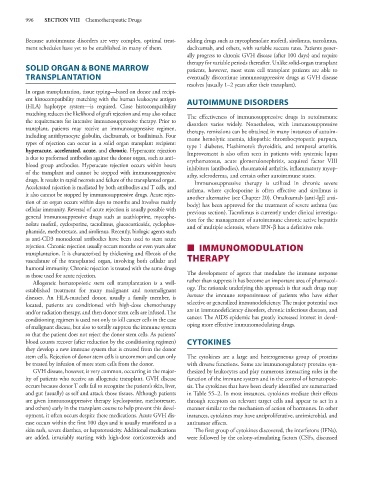Page 1010 - Basic _ Clinical Pharmacology ( PDFDrive )
P. 1010
996 SECTION VIII Chemotherapeutic Drugs
Because autoimmune disorders are very complex, optimal treat- adding drugs such as mycophenolate mofetil, sirolimus, tacrolimus,
ment schedules have yet to be established in many of them. daclizumab, and others, with variable success rates. Patients gener-
ally progress to chronic GVH disease (after 100 days) and require
therapy for variable periods thereafter. Unlike solid-organ transplant
SOLID ORGAN & BONE MARROW patients, however, most stem cell transplant patients are able to
TRANSPLANTATION eventually discontinue immunosuppressive drugs as GVH disease
resolves (usually 1–2 years after their transplant).
In organ transplantation, tissue typing—based on donor and recipi-
ent histocompatibility matching with the human leukocyte antigen AUTOIMMUNE DISORDERS
(HLA) haplotype system—is required. Close histocompatibility
matching reduces the likelihood of graft rejection and may also reduce The effectiveness of immunosuppressive drugs in autoimmune
the requirements for intensive immunosuppressive therapy. Prior to disorders varies widely. Nonetheless, with immunosuppressive
transplant, patients may receive an immunosuppressive regimen, therapy, remissions can be obtained in many instances of autoim-
including antithymocyte globulin, daclizumab, or basiliximab. Four mune hemolytic anemia, idiopathic thrombocytopenic purpura,
types of rejection can occur in a solid organ transplant recipient: type 1 diabetes, Hashimoto’s thyroiditis, and temporal arteritis.
hyperacute, accelerated, acute, and chronic. Hyperacute rejection Improvement is also often seen in patients with systemic lupus
is due to preformed antibodies against the donor organ, such as anti– erythematosus, acute glomerulonephritis, acquired factor VIII
blood group antibodies. Hyperacute rejection occurs within hours inhibitors (antibodies), rheumatoid arthritis, inflammatory myop-
of the transplant and cannot be stopped with immunosuppressive athy, scleroderma, and certain other autoimmune states.
drugs. It results in rapid necrosis and failure of the transplanted organ. Immunosuppressive therapy is utilized in chronic severe
Accelerated rejection is mediated by both antibodies and T cells, and asthma, where cyclosporine is often effective and sirolimus is
it also cannot be stopped by immunosuppressive drugs. Acute rejec- another alternative (see Chapter 20). Omalizumab (anti-IgE anti-
tion of an organ occurs within days to months and involves mainly body) has been approved for the treatment of severe asthma (see
cellular immunity. Reversal of acute rejection is usually possible with previous section). Tacrolimus is currently under clinical investiga-
general immunosuppressive drugs such as azathioprine, mycophe- tion for the management of autoimmune chronic active hepatitis
nolate mofetil, cyclosporine, tacrolimus, glucocorticoids, cyclophos- and of multiple sclerosis, where IFN-β has a definitive role.
phamide, methotrexate, and sirolimus. Recently, biologic agents such
as anti-CD3 monoclonal antibodies have been used to stem acute
rejection. Chronic rejection usually occurs months or even years after ■ IMMUNOMODULATION
transplantation. It is characterized by thickening and fibrosis of the
vasculature of the transplanted organ, involving both cellular and THERAPY
humoral immunity. Chronic rejection is treated with the same drugs
as those used for acute rejection. The development of agents that modulate the immune response
Allogeneic hematopoietic stem cell transplantation is a well- rather than suppress it has become an important area of pharmacol-
established treatment for many malignant and nonmalignant ogy. The rationale underlying this approach is that such drugs may
diseases. An HLA-matched donor, usually a family member, is increase the immune responsiveness of patients who have either
located, patients are conditioned with high-dose chemotherapy selective or generalized immunodeficiency. The major potential uses
and/or radiation therapy, and then donor stem cells are infused. The are in immunodeficiency disorders, chronic infectious diseases, and
conditioning regimen is used not only to kill cancer cells in the case cancer. The AIDS epidemic has greatly increased interest in devel-
of malignant disease, but also to totally suppress the immune system oping more effective immunomodulating drugs.
so that the patient does not reject the donor stem cells. As patients’
blood counts recover (after reduction by the conditioning regimen) CYTOKINES
they develop a new immune system that is created from the donor
stem cells. Rejection of donor stem cells is uncommon and can only The cytokines are a large and heterogeneous group of proteins
be treated by infusion of more stem cells from the donor. with diverse functions. Some are immunoregulatory proteins syn-
GVH disease, however, is very common, occurring in the major- thesized by leukocytes and play numerous interacting roles in the
ity of patients who receive an allogeneic transplant. GVH disease function of the immune system and in the control of hematopoie-
occurs because donor T cells fail to recognize the patient’s skin, liver, sis. The cytokines that have been clearly identified are summarized
and gut (usually) as self and attack those tissues. Although patients in Table 55–2. In most instances, cytokines mediate their effects
are given immunosuppressive therapy (cyclosporine, methotrexate, through receptors on relevant target cells and appear to act in a
and others) early in the transplant course to help prevent this devel- manner similar to the mechanism of action of hormones. In other
opment, it often occurs despite these medications. Acute GVH dis- instances, cytokines may have antiproliferative, antimicrobial, and
ease occurs within the first 100 days and is usually manifested as a antitumor effects.
skin rash, severe diarrhea, or hepatotoxicity. Additional medications The first group of cytokines discovered, the interferons (IFNs),
are added, invariably starting with high-dose corticosteroids and were followed by the colony-stimulating factors (CSFs, discussed

